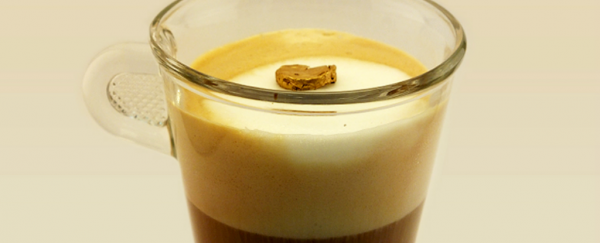The lightest form of gold has been produced by researchers in Switzerland, consisting of 98 percent air, 20-carat gold, and milk protein. While it retains the metallic sheen of its regular form, this new gold aerogel is made almost entirely of air, and it has a range of curious properties that give it potential far beyond the jewellery cabinet.
"The so-called aerogel is a thousand times lighter than conventional gold alloys," says materials scientist Raffaele Mezzenga from ETH Zurich. "It is lighter than water and almost as light as air."
Mezzenga and his team produced the gold aerogel by making a three-dimentional mesh of gold that's almost entirely made up of pores. Of the 2 percent of the material that isn't air, more than four-fifths of it is 20-carat gold, and the rest is nanometre-fine strings of milk protein. (I guess that's what inspired the researchers to top off a latte with the stuff in the image above).
First they had to heat the milk proteins up to produce the tiny fibres - known technically as amyloid fibrils - and these then were mixed into a solution of gold salt. Within this solution, the fibres became interlocked to form a basic structure, and the gold particles crystallised into even smaller particles around it. This formed a gel-like gold fibre network.
The big challenge came next, when the team wanted to dry out the solution without destroying the fine network created by the milk protein fibres and gold. Rather than simply air-drying it, which would have been too harsh, they had to put it through a long and delicate process called supercritical drying, which is also used to decaffeinate coffee.
Throughout the process, the researchers figured out that they could tweak the colour of the aerogel by adding smaller particles of gold to the solution. "When we change the reaction conditions in order that the gold doesn't crystallise into microparticles, but rather smaller nanoparticles, it results in a dark-red gold," said one of the team, Gustav Nyström.
Look how cool it is:
 Nyström G et al. Advanced Materials 2015
Nyström G et al. Advanced Materials 2015
On the far left is a foam of amyloid protein filaments without gold, in the middle is the gold aerogel made of gold microparticles, and on the right is gold aerogel made from gold nanoparticles.
By altering the optical properties of the aerogel - which relate to how it responds to light - the researchers are not only able to tinker with the colours, but can also adjust the material's rate of absorption and reflection.
This means gold aerogel doesn't have to be relegated to 'novelty' applications such as watches and jewellery alone, but has great potential as a new chemical catalyst. With that huge surface area, courtesy of all those pores, the gold aerogel can facilitate chemical reactions at a rapid rate. Another application is in building new types of tiny pressure sensors using the gold foam.
"At normal atmospheric pressure the individual gold particles in the material do not touch, and the gold aerogel does not conduct electricity," says Mezzenga. "But when the pressure is increased, the material gets compressed and the particles begin to touch, making the material conductive."
The material has been described in the journal Advanced Materials.
Fingers crossed this stuff makes it out of the lab and into our lives in some capacity. Gold might be classified as a precious metal, but it's used in everything from smartphones and calculators, to medial diagnoses and lubricants for spacecraft. We can't wait to see where gold aerogel fits in.
